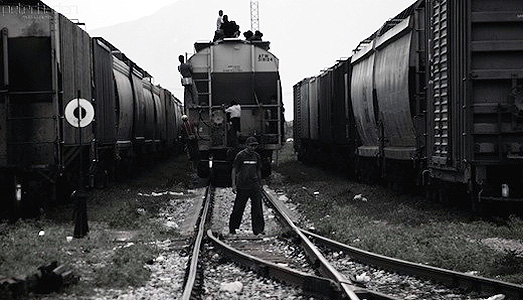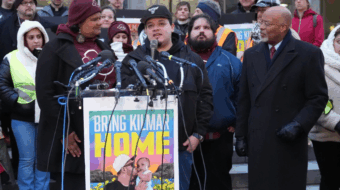
On the night of May 1, 2013, a criminal gang attacked a group of impoverished Central American migrants, who were riding on the top of a freight train passing through Cosoalacaque, in Veracruz, Mexico. The mostly Honduran men were trying to get from Tenosique, Chiapas, on the border with Guatemala, to Reynosa, Texas.
The criminals were trying to rob the travelers and perhaps seize hostages for ransom, as they have often done before. Several people were injured as they jumped or fell from the train trying to escape their attackers. Most of those who fled the scene hid in an overgrown area until residents of the small community of Las Barrancas persuaded them to seek help in the village.
When the Mesoamerican Migrant Movement (Movimento Migrante Mesoamericano) filed a complaint with Veracruz Governor Javier Duarte de Ochoa, his response was that there had been no attack, but rather a drunken brawl among the migrants, a claim refuted by eyewitnesses.
For a number of years, there has been an increase in such migration from Central America and points south. The MMM, which works to defend the rights of Central American migrants passing through Mexico, recorded similar attacks on May 14, 15 and 17, and says there have been hundreds in recent years. In a statement, they said, “We insist once more and we raise our voices to say that on all the migration routes and especially in the states of Tabasco, Chiapas and Veracruz, the tragedies are everyday matters, causing terrible fear for those who live through them and those who bear witness.”
Although the immigration of Mexicans into the United States is perceived (correctly or not), as having slowed, the migration through Mexico of people from Central American countries has increased, as has evidence of horrific abuse inflicted on these migrants both by criminal gangs and corrupt police and officials in Mexico. Thousands have simply disappeared and mass graves have been discovered. In many cases, criminals have kidnapped the travelers as they ride the freight train known as “la Bestia” (the beast), which has twin routes from Chiapas, one to Hidalgo, Texas, and the other to the border across from Nogales, Arizona. The kidnappers then contact their hostages’ relatives in the U.S. with demands for ransom.
In addition to those who’ve been killed en route, thousands more have perished from thirst and exposure in the desert, or have drowned in the Rio Bravo as they attempt to cross into the U.S.
In Mexico, human rights defenders have set up way stations where migrants can receive shelter, food, water and medical attention, and launched campaigns to pressure federal and state governments to protect the rights of the migrants. In 2011, these efforts produced a new federal law that supposedly guarantees that these workers will be protected and given the means to regularize their “migratory status” while they are in Mexico. Yet the governments of both former President Felipe Calderon (of the right wing National Action Party) and current President Enrique Peña Nieto (center-right Revolutionary Institutional Party), have failed to implement this law, some suspect under pressure from the United States.
And the migrants keep coming. Why?
A glance at economic and social conditions in the key Central American countries of Honduras, Guatemala and El Salvador gives the answer.
All three of these countries are very poor. The per capita Gross National Product in Honduras is $4,047, in Guatemala $4,928 and in El Salvador $6,831 (in the United States it is $48,112). Inequality levels in Central America are huge. All these countries are supposed to be rescued from poverty by their membership in the trade pact called CAFTA-DR. (Central American Free Trade Agreement-Dominican Republic) with the U.S. However, as is the case with the similar NAFTA (North American Free Trade Agreement) among Mexico, the United States and Canada, poor farmers are disadvantaged in this agreement because they cannot compete with imported government subsidized farm produce from the United States. The expansion of mining in Central America, especially involving Canadian based transnationals, is displacing some farmers. And right now Guatemala is suffering from a blight of its coffee crop, which is causing many farmers to hit the migrant trail.
Personal security problems are another major reason for Central Americans to migrate. Honduras, El Salvador and Guatemala are on the route of drug smuggling where South American to the U.S.-Mexican drug gangs have set up satellite organizations in Central America. This comes on top of other problems conducing high crime and especially murder rates. The instability set off by the coup d’état in Honduras in spring 2009 has led to a situation where opponents of the ruling class, or of the drug gangs, in that country are killed in shocking numbers. Honduras now has one of the highest murder rates in the world.
All of these things go into the potential migrant’s calculations of the risks entailed in staying or leaving. What tips the scale is often the fact that the migrant already has a family in the United States but was deported before, and is now desperate to get back to his or her loved ones.
In May, a Mexican Roman Catholic Priest, Father Alejandro Solalinde, of the Hermanos en el Camino (Brothers on the Road) organization, which provides shelter and other help to migrants in Mexico, toured the United States with a mission of convincing both policy makers and the public that only a radical and complete immigration reform can solve the problem. He met with community organizations in a number of cities and also with about 20 members of Congress. Father Solalinde and other point out that the United States itself has set the stage for mass labor migration because of the way our trade policies have economically suffocated small farmers, workers and others in poor countries.
Virtually none of this has illuminated the ongoing immigration reform debate in Congress. The idea that U.S. trade and foreign policy might have something to do with migration to the United States is perhaps too threatening to the corporate interests who benefit from current arrangements like NAFTA and CAFTA-DR, and to their political allies. It is up to the movement to raise these issues.
Photo: Migrants from Central America ride atop trains through Mexico making their way to the United States (CC).










